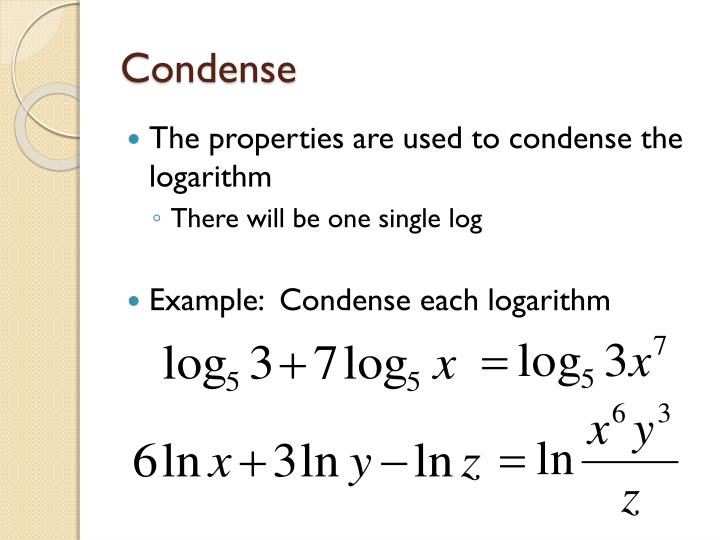


Wouldnt that make this addition instead of subtraction I tried to use the quotient rule and made this be (ln(a)/ln(d))/(ln(c)) but it was wrong. ln(a) ln(d) ln(c) The hint in my homework told me to use the product rule of logarithms in reverse. Now use the power property on the second term. Question 1057547: Condense to a single logarithm with a leading coefficient of 1. First use the product property since the exponent is only on the x and not on the 3. For example, log of base 2 is represented as log 2 and log of base e, i.e. Example 2: Expand a Logarithmic Expression. The difference between log and ln is that log is defined for base 10 and ln is denoted for base e. How do you add logs to both sides of an equation? How do you solve an equation with logs on both sides? To rid an equation of logarithms, raise both sides to the same exponent as the base of the logarithms. What property is used to condense logarithms? To simplify logarithms, write them as a single logarithm. Often, using the rules in the order quotient rule, product rule, and then power rule will be helpful. (One-to-one Properties of Exponential and Log. To expand logarithms, write them as a sum or difference of logarithms where the power rule is applied if necessary. Next, we spell out what it means for exponential and logarithmic functions to be one-to-one. How do you expand logarithms step by step? How do you multiply three logs with different bases? For example log 8 in base 2 + log of 25 in base 5 is the same as log of 8 in base 10 + log 25 in base 10. some logarithm expressions into a single logarithm ( condensing ). You need put the numbers in the different bases to base 10. Expanding and Condensing Logarithms Using some of properties of logs, ( the product. How do you condense logarithms with square roots? The logarithm with base 10, log10 (x), is called a common logarithm, and it is written by leaving the base out as log(x). Rewrite each of the following logarithmic expressions using a single logarithm. No, log10 (x) is not the same as ln(x), although both of these are special logarithms that show up more often in the study of mathematics than any other logarithms. The following properties serve to expand or condense a logarithm or. Use the power rule to drop down the exponent. Using the common log on both sides gives you log 4 3 x – 1 = log 11. You can take any log you want, but remember that you actually need to solve the equation with this log, so you should use common or natural logs only. How do you add two logs with different bases? How do you condense and expand logarithms? How do you write multiple logs as one log? Rewrite sums of logarithms as the logarithm of a product. Identify terms that are products of factors and a logarithm, and rewrite each as the logarithm of a power. Textbook content produced by OpenStax is licensed under a Creative Commons Attribution License.


Use the information below to generate a citation. Then you must include on every digital page view the following attribution: How does this effect the file size The lower the. By choosing one, the quality of your image will be adjusted. If you are redistributing all or part of this book in a digital format, We provide four different presets for you to use. Then you must include on every physical page the following attribution: If you are redistributing all or part of this book in a print format, Want to cite, share, or modify this book? This book uses the


 0 kommentar(er)
0 kommentar(er)
